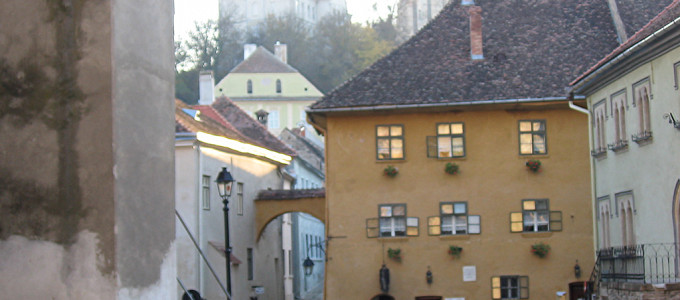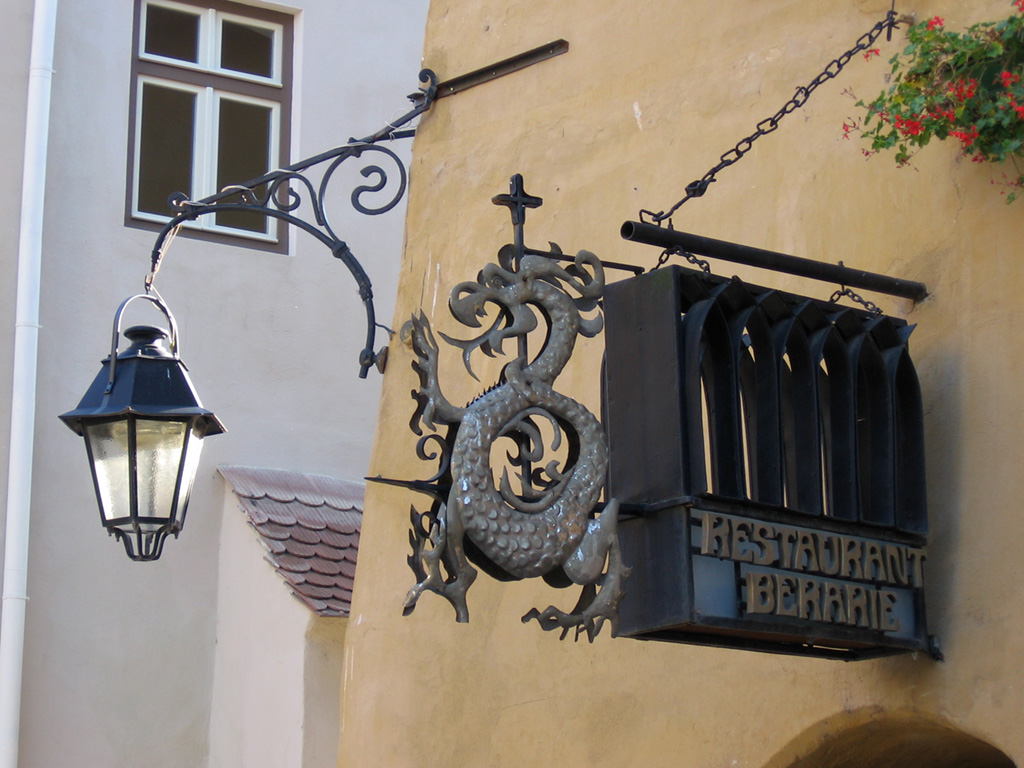Vlad the Impaler’s childhood home in Sighișoara, Romania

These pictures are from my trip to Sighișoara, Romania in 2006. During this whole big trip across Transylvania I wanted to visit as many Dracula-related spots as I could. I’d heard that Vlad’s birthplace had been turned into a touristy restaurant, and as I approached it was immediately clear this was correct!
One small regret I have from this trip is that, as I was backpacking and hitchhiking and traveling with very little money, I had to opt not to eat (or even have a drink) at this restaurant. I only got as close as the front door. So this is definitely on my list of things to do during my next Romania trip.
I’m not sure if the official name of this place is Restaurant Casa Vlad Dracul, as seen on the white sign on the wall, or Restaurant Berărie, as is written on the metal sign.
The Restaurant Berărie sign features a dragon, which is a reference to the Order of the Dragon, of which Vlad and his father were both members, and which is of course the source of their respective nommes de guerre, Dracul and Dracula.
This view of the building from farther away was taken not far from the spot where the bust of Vlad the Impaler is, facing the restaurant. Imagine Vlad playing here as a young boy!
The sign on the wall outside references Vlad the Impaler’s father, Vlad II, aka Dracul, and Vlad’s grandfather, Mircea the Elder. The sign says, “În această casă a locuit între anii 1431-1435 domnitorul Țării Românești Vlad Dracul, fiul lui Mircea cel Bătrân,” which translates as: “In this house between the years 1431-1435 lived the Romanian ruler Vlad Dracul, son of Mircea the Elder.”
It’s interesting to me that Vlad III (Dracula) isn’t mentioned on this sign, but it’s important to remember that he’s a quite bit less prominent in Romanian history than he is in Western literature. The sign also looks a bit old, possibly dating from a few decades ago before Dracula mania had really taken off in modern pop culture. All of the research I’ve done indicates that this is indeed the place of his birth, and I’m assuming that this sign focuses more on his father, Vlad II, because he was actually the ruler of this region during the time he lived here.
I’ll be posting more pics from my travels across Transylvania soon!







If you value culture, history, style and even just plain good taste do not under any circumstances pay good money to the restaurant in Sighisoara to visit Dracula’s birthplace. I was, as a historian, hoping for a preserved chamber of the 15th century. What I got was schlock sh*t with Gothy red drapes, red lighting and some fellow dressed as Christopher Lee hurrying to emerge from a coffin on time. Couldn’t even see the room for the vampire crap. Dreadful. How can the town allow this debacle that ruins the heritage of their lovely town? Shudder worthy. Don’t go
Sighisoara as Vlad’s birthplace, while not impossible, it’s not supported by any historical documents. It’s strongly supported however by owner(s) of the restaurant that functions in the house where he was allegedly born…
The real historical documents we have mention only that a mint functioned there between 1433–1436. You know, a place where coins were manufactured. And deposited until they were transported to wherever people transported money those times. That’s not a place where I can imagine guestrooms, especially for foreign exiled dignitaries. (Although after 1436, and maybe even before 1433 there were guestrooms in the house.)
The plaque was put there in 1976; the assumption that Vlad and his family lived here was proposed in 1945 by a non-historian doctor who discovered some resemblance between a portrait on the wall of one of the rooms and Vlad II; and the dates (1431-1436) were based on two letters written by Vlad Sr., in 1431 and in 1436 respectively, from Sighisoara… This doesn’t even mean that he was there the whole time. And the portrait? Well, the number of the eyes was a match, and so was the moustache… but if you saw Vlad II’s only known portrait (the portrait with the turban), which looks like it was drawn by a not too talented 5-year old kid, you can realize that this is just an amateur historian’s wet dream.
I’ve been planning my trip from my home country of the United States, to cover all of Vlad’s tracks throughout his life, since I was 13 years old. I am now 40 years old and still have no clear directions. This restaurant was originally my first planned stop, but now I’m not even sure about that. Any ideas on how to get concrete evidence of where he was, the places he stayed, paths traveled, anything, would be most helpful. This will be long journey, with many years of planning and I am searching for the man, not the myth. So any information will help. Feel free to email me. Thank you.
[…] colorful houses, cobblestone streets, and impressive clock tower that watches over the city. The birthplace of Vlad the Impaler, who inspired the legend of Dracula, adds a touch of mystery to Sighisoara’s […]